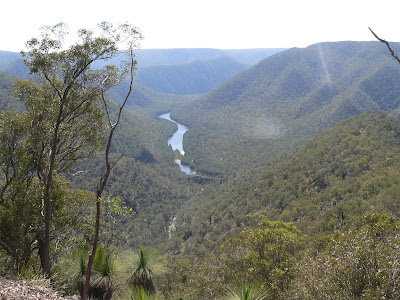Today Bungonia is famous for bushwalking and caving
|
"The Bungonia district was settled in the early 1820s, little more than 30
years after Governor Phillip landed at Port Jackson. The village plan,
drawn up in September 1832, replaced the earlier plans for a settlement
at Inverary and included provision for a recreation area, schools,
churches, a courthouse and other public facilities associated with a
major centre.
Most of the inhabitants were convicts, ex convicts or ticket of leave
men and women working on four or five big properties. As the area
developed and other settlers came, the village progressed and various
small businesses were established to service the district. Butchers,
carriers, shopkeepers, sawyers, stonemasons are some of the listed
occupations in the census and the Post Office Directories. The school,
post office, shop, hotels and the two churches operated from a very early
date.
Surveyor-General Mitchell relocated the main road south through
Goulburn, by-passing Bungonia and ending its prospect of becoming a major
centre.
Bungonia's historical legacy is a number of very fine buildings. Part of
Lumley Park Homestead and the old Hotel Victoria (1837), St. Michael's
Catholic Church (1847) and the old Parsonage(1841) were constructed by
stonemason Patrick Kelly. The old Bungonia School was opened as a Roman
Catholic Denominational School in 1866 with 39 children on the roll. The
building was made of sawn timber with shingles and split slabs, also
providing accommodation for 30 children. In 1868 it was converted into a
Provisional School and then in 1880 it became a Public School. The stone
schoolhouse and residence were built in 1882 at a cost of 750 pounds.
Christchurch (1893) claims a connection with the architect Blacket and
the old Police Station was built in 1907.
All except the churches are now private residences.
Bungonia Park stretches along Woodward and Bungonia Creeks within the
village boundaries. While here, take some time to enjoy the Bogong
Aboriginal Bush-food Garden. The Park is a common meeting place for
various groups, with picnic tables, BBQs, toilet facilities and play
equipment available.
Bungonia is also the gateway to the Bungonia National Park, famous for
its beautiful views, bushwalks, rock climbing, abseiling and canyoning.
The lookouts are easily accessible(including by wheelchair) and a range
of walking tracks cater to all fitness levels. The Bungonia caves system
were discovered in 1829 by William Shelley.
At the Bungonia Lookdown you stand in the Southern Tablelands and look
down over Morton National Park at the South Coast botanical region. Box
woodlands give way to coastal forests with patches of rainforest still
containing occasional Red Cedars (highly prized for its wonderful red
timber and now protected).
In places such as this, the blue-eyed Satin Bowerbirds build their bowers
and raid neighbouring orchards for fruit. The adult males are such a dark
blue that it almost looks black. Younger males and females are shades of
olive green and brown"

No comments:
Post a Comment
Thanks for your comment on Genealogy Boomerangs. All our comments are moderated and it should appear shortly. I hope you enjoyed the read.
Barb